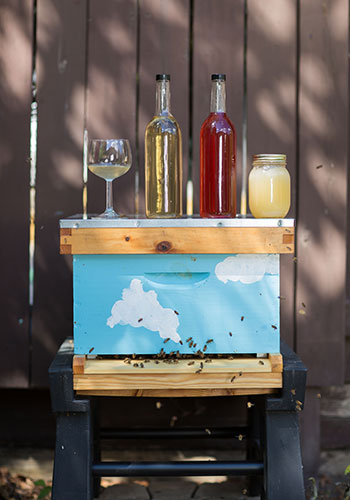How David Whitaker turns honey into something even better
For David Whitaker (Cooking ’83), simplicity ranks among mead’s sweetest attributes.
The alcoholic beverage is so easy to brew that it almost certainly predates wine and beer, with possible origins in Africa 20,000 to 40,000 years ago. In the millennia since – from 8,000 years ago when it was fermented on the island of Crete, to the Middle Ages when it graced English tables and taverns, to now as it enjoys a comeback as one of the fastest growing segments of the alcoholic beverage industry – it has never required more than water, yeast and honey, which are all of the ingredients Whitaker uses to make mead in his north Edmonton kitchen.
“My style is low technology and natural,” says the Culinary Arts instructor.
Whitaker began making mead last year, using tips from a workshop held by a community gardening organization. Inspired largely by YEG Bees, a co-op that piloted beekeeping in the city in 2014, he also started a hive in his garden, against a sunlit back fence. “This would be pretty cool,” he recalls thinking. “I have bees, I have honey.” What’s more, he adds, “It’s fun to make and great to drink.”
Mead also fit Whitaker’s food philosophy, which is earthy and uncomplicated. Once his bees begin making enough honey, he envisions a hyper-local production line, with primary ingredients travelling no more than a few metres from hive to fermenter to dinner table, and undergoing little processing other than what transpires with the introduction of sugar-eating, ethanol-excreting yeast. In the meantime, here’s how he applies age-old wisdom to make a beverage that has stood the test of time.
Brewing
 Mead is a versatile drink, its base ingredients accommodating all manner of additions. While Whitaker’s first batch was just three litres of liquid honey in nine litres of room-temperature tap water, he soon got creative.
Mead is a versatile drink, its base ingredients accommodating all manner of additions. While Whitaker’s first batch was just three litres of liquid honey in nine litres of room-temperature tap water, he soon got creative.
In one follow-up, he added cinnamon-infused poached pears. In another, he added local sour cherries. In neither case did he use anything resembling a recipe.
“Think about what tastes great with honey and mix it,” he says. “Don’t be scared. Just do it.”
Fermenting
Whitaker combines ingredients in a five-gallon (19-litre) pail that’s been sterilized– like anything that will touch the mead from here on in – with a food-grade cleaner purchased from a brewing supply store. He measures the initial sugar content of the
Acclaim for new mead maker
Culinary Arts instructor David Whitaker is already enjoying sweet success in Alberta's burgeoning mead community. In spring 2018, he earned a silver medal for his homemade traditional mead (honey, water and yeast) at the inaugural Horde at the Hive mead competition, held by Chinook Honey Company in Okotoks.
It was the first time Whitaker entered a competition.
Judges gave the chef's "Kilkenny Mead" an average of 87 out of 100 possible points, noting the clarity, herbal aroma, and balance. One drawback: it was a bit boozy (Whitaker didn't check the alcohol content before sending his sample).
"David did a great job with his mead and should be very proud of his silver medal," said Debbie Williams, an operations assistant at Chinook. Whitaker's category contained 12 entries, making it the second-largest of six.
mix with a tool called a hydrometer before adding a package of the same yeast used to make champagne. Then he savours the transformation.
Each day, Whitaker checks to see if the temperature is an optimal 24 C, stirs the mix with a long-handled spoon, tastes it, sniffs it and listens to the delicate popping of carbon dioxide bubbles produced by the yeast as it turns sugar into alcohol. “I’m using all my senses to observe what’s happening,” says Whitaker.
Aging
Once the brew has stopped bubbling and fermentation is complete (usually a week or two), Whitaker siphons it into a glass carboy he has plugged with an airlock, a water-filled device that lets excess CO2 out but nothing in.
After another week or two, the airlock will cease to bubble and particles suspended in the mead will have settled to the bottom of the carboy. It needn’t be perfectly clear, according to Whitaker.
“My mead is a little cloudy,” he says. “I look at it as extra flavour.”
Before bottling, he takes another hydrometer reading, comparing it to the initial measurement to determine the final alcohol content (roughly 14 per cent for his first batch). Then he siphons it into sterilized 750-millilitre bottles. In theory, it should sit, or cellar, at 15 to 18 C for as long as a year, during which time the flavours will mellow. In practice, Whitaker never waits that long. He’s too eager for a taste of the smooth, richly aromatic drink, which he enjoys like wine with dinner (or without).
Whitaker counts his first mead – his most basic – as his favourite so far. “I’m so proud of how it turned out,” he says. “I don’t want to drink it too fast so it will last. But I can always make more.”
A mead for any need
Traditional - Contains only honey, water and yeast
Metheglin - Fermented or flavoured with herbs or spices, including rosemary, thyme and sage
Braggot - Made with malted grain, usually barley
Melomel - Fermented or flavored with fruit
Cyser - A melomel made with apples, apple juice or cider
Pyment - A melomel made with grapes or grape juice
Hippocras - A pyment with spices such as cinnamon and ginger